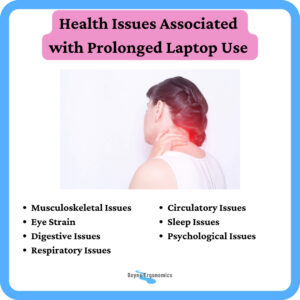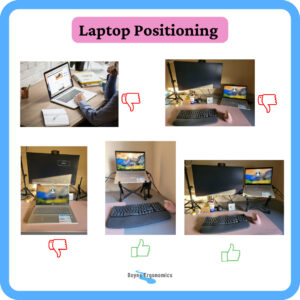For many of us, how we work has changed dramatically since March 2020 and while some of it has been positive, in terms of flexibility and connectivity, the enduring negative that I still encounter on a regular basis is our attachment to our laptops. This is evident, both at office and home workstations, with many DSE based employees still using the laptop as the primary screen or primary keyboard, even when appropriate external devices are available.
From talking to home based DSE users over the last few years, I have found there to be two main reasons for the continued use of the laptop at the workstation – habit and space restrictions.
Firstly, at the beginning of the forced move to home working, most companies provided laptops only for their employees to continue to carry out their work when based at home. This was the case for many DSE based employees for a long period of time, while companies navigated the change from short term emergency home working to long term remote and hybrid working.
In this time, many employees became accustomed to the feel and size of the laptop keyboard, compared to the traditional office keyboard they would have used in the office. When these external devices became available, some employees found it uncomfortable to type on them and chose to continue to use the laptop keyboard instead.
Many employees, particularly those with poor typing technique, found that they preferred having the screen close to the keyboard level, as this allowed the screen and keyboard to be in their line of sight at the same time. In these cases, even when external monitors were provided, the users continued to use the laptop as the primary screen, with the external monitors used as secondary reference screens.
Secondly, it remains that some home based and hybrid employees do not have the space to accommodate a medium to large DSE workstation set up, or do not have a dedicated DSE workstation at all. This can encourage the continued use of the laptop as a full time monitor and keyboard as it takes up minimal space and can be tidied away easily at the end of the working day.
Why Should Frequent or Long Term Laptop Use Be Discouraged?
Firstly, from a compliance point of view, in Ireland the DSE regulations (Health, Safety and Welfare at Work (General Application) Regulations 2007, Chapter 5 of Part 2: Display Screen Equipment states that, as a minimum,
- The screen should be able to swivel and tilt easily and freely
- It should be possible to use either a separate base for the screen or an adjustable table
- The keyboard should be tiltable and separate from the screen
It is not possible to achieve these minimum standards solely with a laptop.
If you, as an employer, do not ensure that the DSE workstations of your employees meet these minimum standards (and there are many more in the regulations not included here) you are in breach of Health and Safety regulations.
Secondly, it is not possible to achieve the optimum or least stressful DSE postures solely with a laptop.
Not to state the obvious, but when using a laptop (and I am not talking about the Surface Pros or Dell Latitudes!) the keyboard and screen are attached. Due to this feature, either the laptop screen or the laptop keyboard can be in the optimum position but not both at the same time.
Finally, given the amount of DSE based tasks required in the working day, particularly when working from home, screen size has to be taken into consideration. For many, the laptop screen is simply too small to allow for comfortable viewing of spreadsheets or reading of documents. Increasing text size will result in an increase in mouse / touchpad / keyboard use to navigate to the required information. Reducing text size can result in eye strain and poor posture.
To put it simply, using a laptop as the sole and primary DSE workstation screen and keyboard requires compromises in posture and eye comfort, with comfort and reduced strain on one area coming at a sacrifice in other areas.
What Are The Ergonomic Risks Associated with Frequent and Long Term Laptop Use?
There have been numerous studies conducted over recent years looking into the negative impact of laptop use on the musculoskeletal system. The main areas of pain and discomfort reported, across the majority of studies, and anecdotally from users I have interacted with are the neck, shoulders, upper back and lower back along with headaches and eye fatigue.
The ergonomic risks associated with standard DSE use include adverse postures, contact stress, prolonged static postures, repetitive movements and stress. These can be present at any home or office workstation.
The main risk factors present with laptop use that contribute to the increased risk of musculoskeletal discomfort are adverse / awkward postures and contact stress. The other risk factors can be present, but I have found that the degree of adverse or awkward postures is larger compared to desktop use and the risk of contact stress is increased.
When using the laptop flat on the work surface, as most users do when they are not using an external keyboard, the laptop screen is much lower than the resting eyeline when seated upright and looking forward. Therefore, looking at the laptop screen encourages adverse postures of the neck, with the neck flexed and head lowered. What tends to follow, after a few minutes of this static neck flexion, is a rounding of the shoulders and a forward lean of the torso.
This prolonged static flexion of the neck increases the workload on the muscles of the neck and shoulders as they hold the weight of the head and counteract the pull force of gravity as the head moves forward from the midline. As these muscles fatigue, the muscles of the upper and mid back assist in holding this position. As these fatigue, the spine and shoulders become rounded, increasing strain on the muscles, ligament and tendons. This is similar to the postures associated with mobile phone use and can cause discomfort collectively known as Tech Neck.
Many laptop users try to reduce the adverse postures associated with low laptop monitor position by increasing the height of the laptop or lowering their own seated position to bring them more in line with the laptop screen. While this may reduce the awkward postures of the neck and shoulders, the keyboard is often then too high for the resting elbow position. This can result in awkward postures of the shoulders, usually in an abducted / winged or raised position, to bring the elbows and forearms into a comfortable position for typing.
The adverse shoulder postures described above or even a relaxed shoulder position when the user is positioned too low for the keyboard results in contact stress between the edge of the laptop or edge of the work surface and the wrists / forearms. This increases the risk of musculoskeletal discomfort and potentially carpal tunnel syndrome.
Also, as the keyboard and screen are connected, if the keyboard is positioned appropriately for relaxed upper limbs then the screen is closer than the recommended distance. If the laptop screen is at the recommended distance then the keyboard is too far away!
Connecting the laptop to an external monitor(s) and using an external keyboard is not always enough to reduce these adverse postures, as this positions the laptop monitor below the external monitor and encourages use of the laptop as a second or third screen, resulting in adverse postures and repetitive movements of the neck.
Unfortunately, elevating the laptop and using an external keyboard and mouse may not be enough to reduce adverse postures.
The small laptop screen size can make it difficult for some users to read text and images. This can increase the risk of forward leaning postures as users lean in to make it easier to read the text. Of course it is possible to increase the text size in most programmes, however, this can be cumbersome to read and edit on screen as the user navigates the different areas of the document / spreadsheet / system.

Other Health Impacts of Adverse Laptop Postures
The adverse postures associated with laptop use does not just negatively impact the musculoskeletal system. There can be a knock on effect on the digestive system, respiratory system, circulatory system, quality of sleep and mood.
Impact on Digestive System
Rounded shoulders and back compresses the organs of the digestive system. This reduces digestive function, increasing the risk of acid reflux and constipation.
Impact on Respiratory System
Rounded shoulders and back causes the muscles in the chest to tighten, limiting rib cage expansion and preventing the diaphragm from opening fully. This results in a more rapid and shallow breathing pattern. This encourages activation of the nervous system and causes the body to be in a state of stress.
Adverse posture also causes additional strain on the primary breathing muscles. The body responds by recruiting other muscles to help with breathing. These are usually the neck muscles, which then become overworked resulting in neck pain, shoulder pain, headaches and migraines.
Impact on Circulatory System
Adverse postures reduce blood flow to the muscles and internal organs affecting their ability to function efficiently.
Increased pressure on the veins, especially in the legs, can damage them and cause varicose veins.
Impact on Sleep
Adverse postures cause increased tension in the muscles, making it difficult to relax the body at night. Muscular pain and discomfort can make it difficult to get into a comfortable position to fall asleep and can increase night wakening. This reduces the duration and quality of sleep.
Impact on Mood
The negative effects mentioned above can act to negatively affect our mood and psychological well being. Adverse postures also negatively affect the nervous system, including compression of the nerves, causing a chain reaction that negatively impacts your emotional and psychological wellbeing.

Reduce the Risks Associated with Laptop Use
Reduce Adverse Postures
The only way to reduce the adverse postures associated with low laptop monitor position or high laptop keyboard position is to separate the keyboard and screen by connecting the laptop to external devices.
In the ideal world, the laptop should be connected to an external keyboard, mouse and monitor and closed over, essentially used as a hard drive only when at a static workstation. This will encourage an upright position, with images and text visible on a larger screen. The keyboard can be close enough for relaxed upper limbs with the screen at an appropriate distance from the working position.
However, most users will use the laptop at the workstation even if external devices are available. If using the laptop at the DSE workstation, it should be used as a second or third screen (if using dual external monitors) and should be elevated on a laptop riser to bring it to your eye line when upright.
If you do not have the space to accommodate external monitor(s), the laptop should be elevated on the laptop riser and the laptop should be connected to an external keyboard and mouse. A foldable laptop riser and compact keyboard will allow the devices to be tidied away and stored in the laptop bag when not in use which is useful if working on the road, from a multi-use work surface at home or in a coworking hub.
If you have become accustomed to using the low profile laptop keyboard or the laptop touchpad, you can get low profile external keyboards and touchpads that feel similar to the laptop. The standard external keyboard and mouse is not the only data inputting option available.
Ensure you are up to date with your eye tests. These should be conducted at least every 2 years to ensure you receive corrective lenses for DSE use if required.
Reduce Contact Stress
When connected to the external devices, check that the keyboard and mouse are level with or just below your resting below position. The best position will depend on the type of devices in use and your typing style. You should not be able to feel the corner of the work surface digging into your forearms.
Avoid Prolonged Static Positioning
If you have to use the laptop only, for example, if using it on the move, limit continued use to 30 – 40 minutes maximum, taking microbreaks from the work area and moving around to allow the muscles to relax and reducing the impact on other internal systems.

Laptop use in the workplace, be it home, office or on the road, is here to stay for the foreseeable future and so we need to focus on safe and appropriate use to reduce the negative impact on our health and wellbeing.


